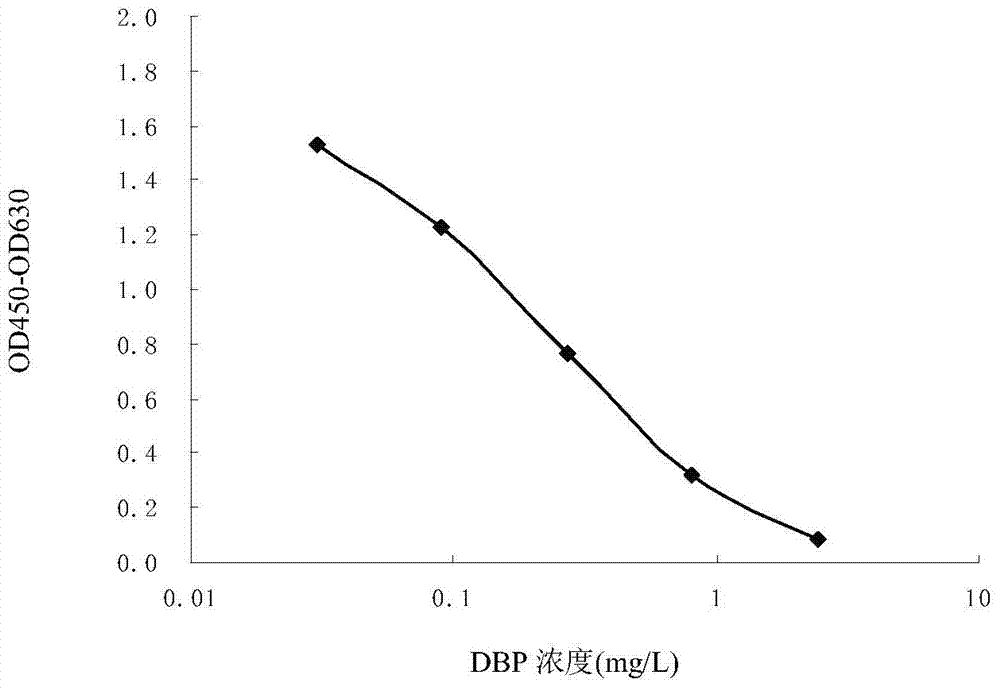Hybridoma cell DBP-4E10 and dibutyl phthalate monoclonal antibody produced by hybridoma cell DBP-4E10
A DBP-4E10, dibutyl phthalate technology, applied in microorganisms, biological testing, biochemical equipment and methods, etc., can solve the problems of complex processing process, time-consuming operation, expensive analysis cost, etc., and achieve good specificity. , the effect of high sensitivity
- Summary
- Abstract
- Description
- Claims
- Application Information
AI Technical Summary
Problems solved by technology
Method used
Image
Examples
Embodiment 1
[0021] Example 1: Screening of hybridoma cell line DBP-4E10
[0022] 1. Antigen synthesis and animal immunization
[0023] 4-Nitrophthalic anhydride undergoes esterification reaction with n-butanol under raw conditions to obtain 4-nitrophthalate dibutyl, and then undergoes reduction reaction with zinc powder under acidic conditions to obtain hapten derivatives 4-aminophthalate dibutyl ester, phthalate hapten derivatives with aniline react with NaNO2 and concentrated HCl at low temperature to generate corresponding diazonium salts; The salt is coupled with the carrier protein to obtain the corresponding artificial antigen.
[0024] Synthesis of 4-nitrophthalate dibutyl
[0025] Dissolve 2.5 grams of 4-nitrophthalic acid in 50 mL of n-butanol, slowly drop 1 mL of concentrated H2SO4 into it as a catalyst, and react at 120 ° C with constant stirring. After the reaction, wash three times with 10% NaCO3, 10 mL each time. Butanol and water were removed by rotary evaporation at 80...
Embodiment 2
[0041] Example 2: Preparation, purification and identification of antibodies
[0042] The obtained hybridoma cell line DBP-4E10 obtained in Example 1 was injected into BALB / c mice pre-treated with Freund's incomplete adjuvant, the ascites of the mice was collected, purified and treated to obtain anti-phthalic acid Monoclonal antibody to dibutyl ester.
[0043] The specific operation is as follows: centrifuge the ascites at 3000r / min at 4°C for more than 5min, absorb the supernatant, mix the supernatant with 2 times the volume of acetate buffer, and slowly add n-octanoic acid while stirring. The volume was 33 μL, mixed at room temperature for 30 minutes, and allowed to stand at 4°C for 2 hours to fully precipitate. Then centrifuge at 12000r / min at 4°C for 30min, discard the precipitate, filter the obtained supernatant with a sand core funnel, add 1 / 10 of the filtrate volume of 0.1mol / L pH7.4 phosphate buffer, add 2 mol / L Adjust the pH to 7.4 with sodium hydroxide solution, pr...
Embodiment 3
[0048] Embodiment 3: the application of antibody
[0049] The anti-dibutyl phthalate monoclonal antibody secreted by the hybridoma cell line DBP-4E10 was used in the dibutyl phthalate monoclonal ELISA addition recovery test, and the specific steps were as follows:
[0050] (1) Coating: use a 96-well polystyrene microplate plate, dilute DBP-BSA to 1 μg / mL with 0.05mol / L pH 9.6 carbonic acid buffer, and use a multi-channel adjustable pipette gun (referred to as the discharge gun) to Add 100 μL to each well, cover the microtiter plate with plastic wrap, and place it at 4°C overnight.
[0051] (2) Plate washing: The next day, take the microplate out from 4°C, wash with PBST, 250 μl per well, wash 4 times, and pat dry on a towel after washing.
[0052] (3) Sealing: add 200 μL of 1% BSA PBS to each well with a row gun, cover the microplate plate with a lid after adding, and place it at 37°C for 2 hours. Wash with PBST, 250 μl per well, wash 4 times, and pat dry on a towel after wa...
PUM
| Property | Measurement | Unit |
|---|---|---|
| reaction rate constant | aaaaa | aaaaa |
| reaction rate constant | aaaaa | aaaaa |
| reaction rate constant | aaaaa | aaaaa |
Abstract
Description
Claims
Application Information
 Login to View More
Login to View More - R&D Engineer
- R&D Manager
- IP Professional
- Industry Leading Data Capabilities
- Powerful AI technology
- Patent DNA Extraction
Browse by: Latest US Patents, China's latest patents, Technical Efficacy Thesaurus, Application Domain, Technology Topic, Popular Technical Reports.
© 2024 PatSnap. All rights reserved.Legal|Privacy policy|Modern Slavery Act Transparency Statement|Sitemap|About US| Contact US: help@patsnap.com








